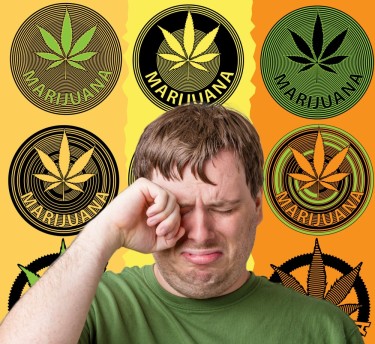
Cannabis faces such strong social disapproval in New York that some residents prefer not to encounter it at all. To eliminate the visibility of cannabis billboards and signs across the state, a New York Republican is pushing for stricter regulations and increased penalties for existing sign restrictions.
Assemblyman Scott Gray (R-Watertown) has put forth A8200, a bill that proposes heightened consequences for individuals displaying cannabis-related signs daily. The legislation seeks to restrict the promotion of cannabis through advertisements unless the ads are endorsed by an authorized dealer and situated on the premises of an authorized business.
New York has already implemented extensive restrictions on cannabis-related billboards. Recently established regulations by the state’s Office of Cannabis Management prohibit such billboards for all cannabis businesses except those engaged in retail sales or delivery. Even for these exceptions, signs are strictly limited to informing consumers of the business location.
The surge in cannabis billboards has sparked concern, particularly regarding an ad that mimics the famous “Got Milk?” campaign but with a cannabis twist—saying “Got Weed?” This advertisement has irked lawmakers, with one expressing worry that it might appeal to teenagers.
According to reports from The Post-Journal, Assemblyman Scott Gray commented on the challenges in the Office of Cannabis Management’s rollout, citing delays, turmoil, and confusion.
Gray highlighted the broader concern among New Yorkers that cannabis product advertisements could target adolescents, potentially reaching those who are not legally of age to possess cannabis or its products.
He pointed to a specific instance in his district where a prominent billboard features a conspicuous “Got Weed?” ad, closely resembling the earlier “Got Milk?” campaign directed at teenagers.
On a related note, the famous “Got Milk?” slogan doesn’t necessarily offer the healthiest guidance either. It turns out that consuming cow’s milk daily could pose risks, as dairy stands as the primary source of saturated fat, which is linked to heart disease, type 2 diabetes, and Alzheimer’s disease.
Additionally, it may increase the likelihood of developing ovarian or prostate cancers, and the recommended food groups, including dairy, were discarded decades ago.
The proposed bill aims to restrict roadside signage promoting the sale of cannabis or cannabis products along roads and highways. It suggests imposing a civil penalty of $1,000 for the initial offence, with subsequent fines potentially reaching up to $2,500 for each day of continued violation.
According to Gray, numerous scientific studies have highlighted the significant impact of marijuana on the teenage brain, and this legislation aims to ensure that products are not promoted in a harmful manner.
Simultaneously, it seeks to safeguard the rights of authorized establishments to display signage indicating their venue’s location. It’s important to note that this legislation does not prohibit signage for retail operations but explicitly targets product advertising.
Among the states with adult-use cannabis, including New York, three prohibit cannabis advertising on public property. In Oregon, the distribution of handbills on public property is restricted, and eight states, including New York, disallow cannabis advertising on public vehicles and mass transit. Six states have bans on cannabis advertising at transportation-related locations, such as roads.
Additionally, three states, including New York, impose restrictions on general visibility through signs and billboards. Alaska sets a limit of three signs per cannabis business, visible from a public right of way.
Other States Act on Cannabis Signage
Several states have taken steps to impose restrictions on cannabis-related advertisements and billboards. In Michigan, State Representative Mary Whiteford, a Republican from Allegan County, introduced House Bill 4609 in 2021, aiming to prohibit cannabis billboards in the state.
Although the bill initially faced a slow start, it aligns with Michigan’s existing regulations, akin to New York, which oversees cannabis billboards through the state’s Marijuana Regulatory Agency.
Reflecting on her motivation, Whiteford shared that about four years ago, when medical marijuana and recreational marijuana were legalized, she had a great concern among the youth. She feared that they would find using marijuana as an acceptable form of recreation, and that bothered her.
She added that she had a niece who was addicted to drugs and took her life when she was 23 years old. And she knows that she was exposed to marijuana as a teenager and was using it. So she does find in her heart that it’s not good for children to be using marijuana.”
California has experienced a back-and-forth trajectory on the issue of cannabis billboard regulations. A 2021 regulation from the California Bureau of Cannabis Control has reversed a prior decision, which had permitted billboards as long as they were outside a 15-mile radius of the state border.
Under the previous ruling, cannabis billboard advertising was permitted along state and interstate highways. Although cannabis billboards are still allowed, the recent regulation prohibits them on any highway crossing state borders.
In Utah, billboards were crucial in encouraging state voters to pass Prop. 2, legalizing medical cannabis successfully. Now, New York legislators are responsible for determining the appropriate guidelines for cannabis-related signage and billboards along roadways.
Conclusion
The landscape of cannabis advertising and signage is undergoing significant shifts across various states. Legislators, motivated by concerns about the impact on public health, particularly youth, are actively reevaluating and amending regulations. From New York’s
Assemblyman Scott Gray’s push to restrict cannabis billboards to Michigan’s Representative Mary Whiteford’s efforts to ban such advertisements, the issue is gaining attention on a national scale.
California’s recent regulatory changes showcase the ongoing dialogue around balancing cannabis billboard allowances. The intricate dance between public perception, health considerations, and the legitimate presence of authorized cannabis establishments is a central theme in these discussions.
As different states grapple with this complex issue, it remains to be seen how the evolving landscape of cannabis advertising will shape public attitudes and behaviours. The ongoing dialogue reflects a broader societal effort to navigate the nuanced intersection of personal freedom, public health, and the expanding cannabis industry.
CANNABIS BILLBOARDS IN THE NEWS, READ ON…
BORAT CANNABIS BILLBOARD GETS SOLAR INTO HOT WATER!
- SEO Powered Content & PR Distribution. Get Amplified Today.
- PlatoData.Network Vertical Generative Ai. Empower Yourself. Access Here.
- PlatoAiStream. Web3 Intelligence. Knowledge Amplified. Access Here.
- PlatoESG. Carbon, CleanTech, Energy, Environment, Solar, Waste Management. Access Here.
- PlatoHealth. Biotech and Clinical Trials Intelligence. Access Here.
- Source: http://cannabis.net/blog/news/antipot-karens-rise-up-in-new-york-scott-gray-rny-wants-cannabis-billboards-banned-because-he-d




